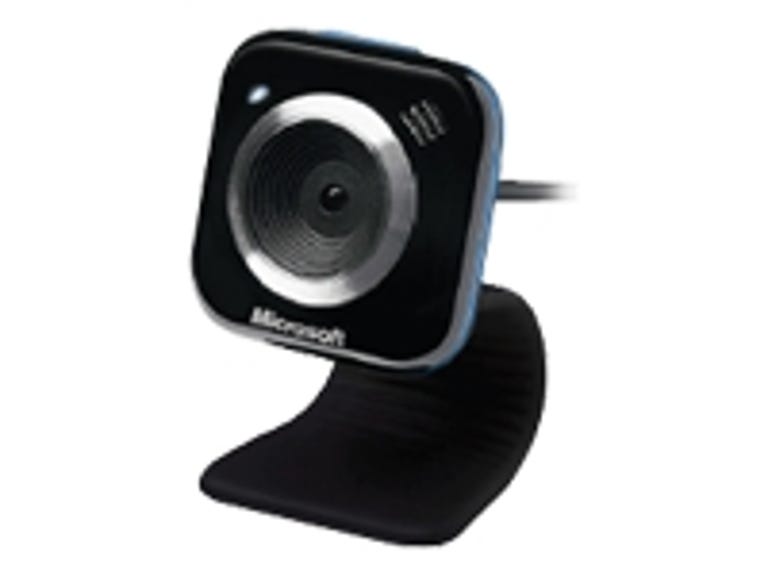 Why You Can Trust CNET
Why You Can Trust CNET Microsoft LifeCam VX-5000 review: Microsoft LifeCam VX-5000
Microsoft LifeCam VX-5000
The Microsoft LifeCam VX-5000 offers vastly superior performance and a much improved design compared with last year's LifeCam NX-3000 model. The VX-5000 features a square shaped camera body on top of a bendable, rubber stand, which makes it easy to position on your laptop, LCD, or desk. Underneath the hood, the VX-5000 received a new image sensor and lens that results in stellar image quality, particularly in low light. Aside from an updated look, the bundled LifeCam software is unfortunately the same lackluster application that shipped with last year's LifeCams. Still, you won't find a better performing Webcam for $50 when it's released next month.
The Good
The Bad
The Bottom Line
Last year's LifeCam models, the NX-3000 (meant for laptops) and VX-7000 (for desktops), featured rectangular cameras connected to clips that were meant for the top of a laptop or LCD but not your desk. The VX-5000's camera is a 1.75 inch by 1.75-inch square, and it's connected to a 3.4-inch rubber tail. The middle portion of the tail can bend, and it holds its shape. The rubber is also heavy enough to counteract the weight of the camera, which lets you find a stable position whether it's resting on top of a thin laptop lid or thicker LCD or CRT monitors. Curve the rubber tail into a C shape, and you can perch the VX-5000 on top of your desk.
The camera body and rubber stand are black, but Microsoft offers a slight nod toward customization by making the camera in one of three colors. We received the red model; green and blue are the other options. The camera swivels from side to side, to about 30 degrees in either direction, but it doesn't offer any tilt. To adjust the camera up or down, you will need to fiddle with the rubber base to reposition it. A Windows Live Call button on the top of the camera brings up your IM contacts to start a video call, but you are almost certain to accidentally hit it when attempting to adjust the position of the camera.
Under the hood, the VX-5000 features a standard VGA sensor that captures 640x480 video and still images (it can also snap 1.3-megapixel stills through software interpolation). What's changed, however, is the size of the pixels on the camera's sensor. According to Microsoft, the pixels are 2.4 times larger than the NX-3000's. The lens has a large aperture that lets more light reach the sensor. The combined effect of the new optics was readily apparent.
The two LifeCam models I reviewed last year were merely average performers, and both really struggled in low light. The LifeCam VX-5000 featured marked improvement, particularly in low-light scenarios. It showed little of the graininess that plagued last year's LifeCams. In a darkened room with really only the light of the laptop screen illuminating my face, the picture was bright and clean with accurate colors and very little noise. With the camera turned to my wife sitting next to me on the couch, with no light source near her, the picture was well rendered. It was every bit as good as the Logitech QuickCam Pro 9000, which uses Logitech's RightLight technology with good results in low light. Better yet, the LifeCam VX-5000 is cheaper and has a better design than the Logitech cam.
Webcams also struggle to keep up with fast-moving scenes. I performed a little kung fu fighting in front of the VX-5000, and dropped frames were few and far between. Image quality also degrades with any Webcam when video conferencing rather than simply recording a video. The VX-5000 is no different in this regard, but it still provided a very good image when using Skype. The image was cleaner and much less washed out than my MacBook's integrated camera, for example, with brighter, more accurate colors.
Unfortunately, it ships with the same LifeCam software. It has an updated look but the same functionality underneath. I wasn't a fan of the application last year (read my reviews of the NX-3000 and VX-7000 for more), and I'm no more a fan of it today. It makes it easy enough to record video or audio or snap a picture, but the e-mail button forces you to answer 20 questions before letting you simply e-mail a video or still image. The video effects are more lame than goofy, and the LifeCam window shows only your last video or still image captured as opposed to the more useful strip of thumbnails that Logitech's QuickCam software provides. You can easily open the folder to where video and images taken with the VX-5000 are stored, however. Microsoft says an overhaul to its LifeCam application is slated for this fall.
Microsoft backs the LifeCam VX-5000 with a three-year warranty.


